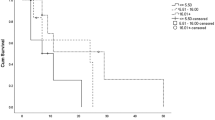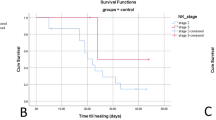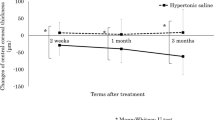Abstract
Background
Topical insulin can promote and accelerate corneal regeneration, even in eyes with serious comorbidities, and offers several benefits over other treatment options.
Aims
The aim of this study is to evaluate the effect of topical insulin in treatment of recurrent epithelial corneal erosion.
Methods
Patients with recurrent epithelial erosions were included in a prospective non-randomized hospital-based study, divided into two groups, one of them received persistent epithelial defects (PEDs) conventional treatment and the other received the same treatment with insulin eye drops 4 times/day. All patients were examined carefully by slit lamp. Patients during the 1st, 2nd, 3rd, and 4th weeks as well as after 2 months. Demographics, etiology, therapy, comorbidities, and the healing time of PED were performed.
Results
Area shows significant improvement after 2 weeks (p = 0.006), 2 months (p = 0.046), and 3 months (p = 0.002) in group II (cornetears gel and topical insulin) as compared to group I (cornetears gel). The recurrence was statistically significant decreased with cornetears gel and topical insulin (group II) by 0.0%, as compared to cornetears gel (group I) by 3 patients (21.4%).
Conclusion
Topical insulin can promote corneal reepithelization in recurrent epithelial erosion and decreases recurrence in these cases. Other advantages include excellent tolerance, availability, and cost-effectiveness.


Similar content being viewed by others
Data availability
The authors declare that all data supporting the findings of this study are available within the article and its supplementary information file.
References
DelMonte DW, Kim T (2011) Anatomy and physiology of the cornea. J Cataract Refract Surg 37:588–598. https://doi.org/10.1016/j.jcrs.2010.12.037
Musa M, Zeppieri M, Enaholo ES et al (2023) An overview of corneal transplantation in the past decade. Clin Pract 13(1):264–279. https://doi.org/10.3390/clinpract13010024
Sridhar MS (2018) Anatomy of cornea and ocular surface. Indian J Ophthalmol 66(2):190–194. https://doi.org/10.4103/ijo.IJO_646_17
Eghrari AO, Riazuddin SA, Gottsch JD (2015) Overview of the cornea: structure, function, and development. Prog Molecul Biol Translat Sci 134:7–23. https://doi.org/10.1016/bs.pmbts.2015.04.001
Wilson SE, Medeiros CS, Santhiago MR (2018) Pathophysiology of corneal scarring in persistent epithelial defects after PRK and other corneal injuries. J Refract Surg 34(1):59–64. https://doi.org/10.3928/1081597X-20171128-01
Vaidyanathan U, Hopping GC, Liu HY et al (2019) Persistent corneal epithelial defects: a review article. Med Hypothesis. Discov Innov Ophthalmol 8(3):163–176. PMID: 31598519; PMCID: PMC6778469
Guerra NP, Reifschneider E, Becker SL et al (2023) Recurrent corneal erosions related to an ocular injury 15 years before presentation. Am J Ophthalmol Case Rep. 29:101787. https://doi.org/10.1016/j.ajoc.2022.101787
Nanba H, Mimura T, Mizuno Y et al (2019) Clinical course, and risk factors of recurrent corneal erosion: observational study. Medicine 98(16):e14964. https://doi.org/10.1097/MD.0000000000014964
Balal S, Ansari AS, Sim PY et al (2023) The incidence and prevalence of recurrent corneal erosion syndrome in London. UK Eye 10:1–4. https://doi.org/10.1038/s41433-023-02490-3
Diez-Feijóo E, Grau AE, Abusleme EI et al (2014) Clinical presentation and causes of recurrent corneal erosion syndrome: review of 100 patients. Cornea 33(6):571–575. https://doi.org/10.1097/ICO.0000000000000111
Suri K, Kosker M, Duman F et al (2013) Demographic patterns and treatment outcomes of patients with recurrent corneal erosions related to trauma and epithelial and bowman layer disorders. Americ J Ophthalmol 156(6):1082–1087. https://doi.org/10.1016/j.ajo.2013.07.022
Yeu E, Hashem O, Sheha H (2022) Treatment of epithelial basement membrane dystrophy to optimize the ocular surface prior to cataract surgery. Clin Ophthalmol 1:785–795. https://doi.org/10.2147/OPTH.S356421
Miller DD, Hasan SA, Simmons NL et al (2019) Recurrent corneal erosion: a comprehensive review. Clin Ophthalmol 13:325. https://doi.org/10.2147/OPTH.S157430
Fu-Shin XY, Yin J, Xu K et al (2010) Growth factors and corneal epithelial wound healing. Brain Res Bullet 81(2–3):229–235. https://doi.org/10.1016/j.brainresbull.2009.08.024
Fai S, Ahem A, Mustapha M et al (2017) Randomized controlled trial of topical insulin for healing corneal epithelial defects induced during vitreoretinal surgery in diabetics. Asia-Pacific J Ophthalmol 6(5):418–424. https://doi.org/10.22608/APO.201780
Wang AL, Weinlander E, Metcalf BM et al (2017) The use of topical insulin to treat refractory neurotrophic corneal ulcers. Cornea 36(11):1426. https://doi.org/10.1097/ICO.0000000000001297
Galvis V, Niño CA, Tello A et al (2019) Topical insulin in neurotrophic keratopathy after resection of acoustic neuroma. Arch Soc Esp Oftalmol 94(2):100–104. https://doi.org/10.1016/j.oftal.2018.06.003
Katzman LR, Jeng BH (2014) Management strategies for persistent epithelial defects of the cornea. Saudi J Ophthalmol 28(3):168–172. https://doi.org/10.1016/j.sjopt.2014.06.011
Jeng BH, Dupps WJ (2009) Autologous serum 50% eyedrops in the treatment of persistent corneal epithelial defects. Cornea 28(10):1104–1108. https://doi.org/10.1097/ICO.0b013e3181a2a7f6
Zagon IS, Klocek MS, Sassani JW et al (2007) Use of topical insulin to normalize corneal epithelial healing in diabetes mellitus. Arch Ophthalmol 125(8):1082–1088. https://doi.org/10.1001/archopht.125.8.1082
Titone R, Zhu M, Robertson DM (2018) Insulin mediates de novo nuclear accumulation of the IGF-1/insulin hybrid receptor in corneal epithelial cells. Sci Rep 8(1):1–3. https://doi.org/10.1038/s41598-018-21031-7
Diaz-Valle D, Burgos-Blasco B, Gegundez-Fernandez JA et al (2021) Topical insulin for refractory persistent corneal epithelial defects. Europ J Ophthalmol 31(5):2280–2286. https://doi.org/10.1177/1120672120958307
Bastion ML, Ling KP (2013) Topical insulin for healing of diabetic epithelial defects: a retrospective review of corneal debridement during vitreoretinal surgery in Malaysian patients. Med J Malaysia 68(3):208–216. PMID: 23749008
Ramamurthi S, Rahman MQ, Dutton GN et al (2006) Pathogenesis, clinical features, and management of recurrent corneal erosion. Eye 20(6):635–644. https://doi.org/10.1038/sj.eye.6702005
Stuard WL, Titone R, Robertson DM (2020) The IGF/insulin-IGFBP axis in corneal development, wound healing, and disease. Frontiers Endocrinol 11(24):1–15. https://doi.org/10.3389/fendo.2020.00024
Author information
Authors and Affiliations
Corresponding author
Ethics declarations
Ethical standards
The authors assert that all procedures contributing to this work comply with the ethical standards of the relevant national and institutional guidelines on human experimentation and with the Helsinki Declaration of 1975, as revised in 2008.
Competing interests
The authors declare no competing interests.
Additional information
Publisher's Note
Springer Nature remains neutral with regard to jurisdictional claims in published maps and institutional affiliations.
Rights and permissions
Springer Nature or its licensor (e.g. a society or other partner) holds exclusive rights to this article under a publishing agreement with the author(s) or other rightsholder(s); author self-archiving of the accepted manuscript version of this article is solely governed by the terms of such publishing agreement and applicable law.
About this article
Cite this article
Esmail, A., Ibrahim, M. & Nage, S. Efficacy of topical insulin for recurrent epithelial corneal erosions. Ir J Med Sci 192, 3117–3123 (2023). https://doi.org/10.1007/s11845-023-03373-y
Received:
Accepted:
Published:
Issue Date:
DOI: https://doi.org/10.1007/s11845-023-03373-y




